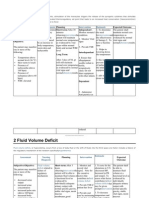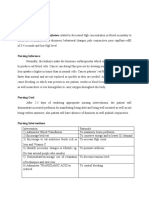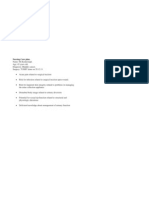NCP
NCP
Uploaded by
Gian Arlo Hilario CastroCopyright:
Available Formats
NCP
NCP
Uploaded by
Gian Arlo Hilario CastroOriginal Title
Copyright
Available Formats
Share this document
Did you find this document useful?
Is this content inappropriate?
Copyright:
Available Formats
NCP
NCP
Uploaded by
Gian Arlo Hilario CastroCopyright:
Available Formats
Cues Objective: >exposure to environment >Improper hygiene >Inappropriate use of antibiotic drugs >Unsafe sexual intercourse
Nursing Diagnosis Risk of infection due to miscarriage or abortion.
Inference The immune system is alerted that an invader has entered the body. Cytokines are the messengers that alert the body to fight the infection. Depending on the type of infection, there are other defender the immune system calls up to join the fight. The result of all this acting often results in a fever. Infection causes blood vessel to enlarge in other to increase the amount of blood containing phagocytes & lymphocyte to the site of infection.
Planning after 4hrs of nursing intervention; >the patient verbalize understanding of individual causative/risk factor >Identify interventions to prevent risk of infection. >Demonstrate techniques; life style changes to promote safe environment.
Nursing Intervention Dependent: >asses for sign and symptoms of sepsis; fever, chills & diaphoresis. >advice patient for proper hygiene. >review individual nutritional needs and appropriate exercise. >promote safer sex. >Provide info. In appropriate community & national education programs. Independent: >Emphasize necessity of taking antivirals/ antibiotics as directed. >discuss of importance of not taking antibiotic using leftover drugs unless specifically instructed by healthcare provider.
Rationale >To monitor if the patient is high risk for infection. >A first line of defense against infections. >to increase the immune system to fight against infection. >to prevent spread of microorganisms. >to increase awareness of & to prevent of communicable disease >premature discontinuation of treatment when current begins to feel well may result in return of infection & potentiate drug resistant strains.
Evaluation After 4hrs of my nursing intervention the patient adopted new information on how to prevent herself for infection.
Cues
Nursing Diagnosis Miscarriage due to lack of knowledge for benefits of taking vitamins and prenatal checks-up.
Inference
Planning
Nursing Intervention
Rationale
Evaluation
Subjective: wala akong ininum na kahit anong vitamins at hindi pa ako nag papa checkup as verbalizes by the patient. Objectives: >body weakness >pallor >viganal bleeding T-36.9 P-85 R-17 BP-80/60
Vaginal bleeding originates from the decidual implantation site or from the placenta. The onset of bleeding may follow or precede fetal demise. Immunologic, hypoxic & vascular lead to final common pathway of severe villous or placental dysfunction resulting in embryonic or fetal demise.
After 4hrs of nursing intervention: >identify interference to learning of specific action to deal w/them. >exhibit increase interest/assume responsibility for own learning beginning to look for info & ask questions. >verbalizes understanding of conditions process & treatment. >initiate necessary lifestyle changes & participate in treatment regimen.
>Explain to the patient why miscarriage happens. >Explain to the patient the importance of taking vitamins and prenatal checkup >asses the level of the clients capabilities & the possibilities of the situation. >discuss to the patient the right birth spacing. >Explain to the patient the effect of smoking to her baby.
>to know the patient why she experience miscarriage. >to know the patient the benefits of vitamins & prenatal checks-up for her and for her baby. >the patient may need help & for nurse (me) to learn about the situation. >to know the benefits of birth spacing and how to apply it to her life. >for avoidance using cigarette s when/during pregnancy.
After my 4hrs of nursing intervention: The patient adopted a lot of information about her situation. The patient responses to learning plan & action performs.
Cues
Nuring Diagnosis Deficient fluid volume related to excessive blood loss.
Inference
Planning
Nursing Intervention
Rationale
Evaluation
Objectives: >delayed capillary refill >restlessness T-36.9 P-85 R-17 BP-80/60 Subjective: dalawang araw na kong dinugo at masakit ang puson ko as verbalized by the patient.
Threatened abortion occurring before th the 20 week of gestation characterized by cramping & vaginal bleeding w/ no cervical dilation, it may subside or an incomplete abortion may follow.
After 4hrs of my nursing intervention the patient will: >demonstrat e improved fluid balance as evidenced by stable vital sign, good skin turgor and prompt capillary refill.
Independent: >Monitor v/s and compare it to previous normal findings. >note patient s individual physiological response to bleeding such as changes in mentation, weakness, restlessness and pallor. >measure central venous pressure, if available. >monitor intake & output & correlate w/ weight changes >maintain bed rest. Dependent: >administer fluids as indicated >administer Vit k >monitor Hb,Hct and RBC
>changes in blood pressure may use for estimate of blood >symptomatology may be useful in gauging severity of length of bleeding episode, worsening of symptoms may reflect continued bleeding or inadequate fluid replacement. >provides guidelines for fluid replacements. >activity increase intra-abdominal pressure & can predispose to further bleeding. >fluid replacement w/isotonic solution depends on the degree & duration of bleeding >promotes hepatic synthesis of coagulation factor to support clotting. >aids in establishing blood replacements needs & monitoring the effectiveness of theraphy.
After 4hrs of nursing intervention the patient was able to demonstrate improved fluid balance as evidenced by stable v/s, good skin turgor and prompt capillary refill.
You might also like
- USMLE Step 3 Lecture Notes 2021-2022: Internal Medicine, Psychiatry, EthicsFrom EverandUSMLE Step 3 Lecture Notes 2021-2022: Internal Medicine, Psychiatry, EthicsRating: 5 out of 5 stars5/5 (9)
- Wolverhampton NHS Interview QuestionsDocument10 pagesWolverhampton NHS Interview QuestionsChristiana OnyinyeNo ratings yet
- NCP - HmoleDocument8 pagesNCP - HmoleChloe Opiña100% (6)
- Dermatomyositis NCPDocument3 pagesDermatomyositis NCPMakki MarcosNo ratings yet
- Drug Study 2Document10 pagesDrug Study 2jedialecarceleryahooNo ratings yet
- NCP CSDocument9 pagesNCP CSFreida Marie PiczonNo ratings yet
- Drug Study 2Document7 pagesDrug Study 2Jediale CarcelerNo ratings yet
- The Use of ThrombolyticsDocument9 pagesThe Use of ThrombolyticsNestleNo ratings yet
- DengueDocument14 pagesDengueKarenn Joy Concepcion OctubreNo ratings yet
- Parenteral Nutrition Basic IVT Nov 2008Document53 pagesParenteral Nutrition Basic IVT Nov 2008Crystal Mae Castrodes DaquipilNo ratings yet
- Medicine 2Document56 pagesMedicine 2Precious NatashaNo ratings yet
- Gnur 405 SuzyDocument6 pagesGnur 405 SuzySeth MensahNo ratings yet
- Nclex 3500Document4 pagesNclex 3500chitor100% (1)
- Management of Dengue Hemorrhagic FeverDocument7 pagesManagement of Dengue Hemorrhagic FeverjoycevillamorNo ratings yet
- Chinese General Hospital Colleges College of Nursing Discharge PlanDocument4 pagesChinese General Hospital Colleges College of Nursing Discharge PlanTin BernardezNo ratings yet
- University of Santo Tomas: The Graduate SchoolDocument19 pagesUniversity of Santo Tomas: The Graduate SchoolJohn Henry ValenciaNo ratings yet
- Acute GastritisDocument14 pagesAcute GastritisMenchie Vivas-AlotNo ratings yet
- Approach To The Care of Surgical PatientDocument45 pagesApproach To The Care of Surgical PatientBright KumwendaNo ratings yet
- Diagno SIS Planni NG Intervention Rationale Evaluati ONDocument3 pagesDiagno SIS Planni NG Intervention Rationale Evaluati ONAnn Nicole G. NeriNo ratings yet
- Cervical Cancer ChemotherapyDocument6 pagesCervical Cancer ChemotherapyTheeya Quigao0% (1)
- Acute Gastritis in PediaDocument13 pagesAcute Gastritis in PediaMenchie Vivas-AlotNo ratings yet
- Planning (Nursing Care Plans)Document10 pagesPlanning (Nursing Care Plans)Kier Jucar de GuzmanNo ratings yet
- New Born NCPDocument8 pagesNew Born NCPCarl Vincent Marrion Rejuso100% (1)
- Abruptio Placenta Nursing Care PlanDocument2 pagesAbruptio Placenta Nursing Care PlanJharene Basbaño100% (5)
- Ineffective Tissue Perfusion Related To Decreased HGB Concentration in Blood Secondary ToDocument6 pagesIneffective Tissue Perfusion Related To Decreased HGB Concentration in Blood Secondary Toericke_tanNo ratings yet
- Nursing Care Plan: Assessment Diagnosis Inference Planning Intervention Rationale EvaluationDocument3 pagesNursing Care Plan: Assessment Diagnosis Inference Planning Intervention Rationale EvaluationJessa FabicoNo ratings yet
- Nursing Care PlanDocument23 pagesNursing Care PlanLorielle HernandezNo ratings yet
- Pharmacology Kylie ThomasDocument17 pagesPharmacology Kylie ThomasRebekah RobertsNo ratings yet
- DischargeDocument49 pagesDischargejonel_amarille100% (1)
- Pre-Operative Nursing CareDocument79 pagesPre-Operative Nursing CarePeter FrimpongNo ratings yet
- Post Assessment PediatricsDocument4 pagesPost Assessment Pediatricscuicuita100% (4)
- Rational Use of AntibioticsDocument85 pagesRational Use of AntibioticsAHMAD MAHIR BIN CHE RAHMATNo ratings yet
- Abruptio NCPDocument4 pagesAbruptio NCPShien Samalea Vasquez100% (1)
- MS QuizDocument18 pagesMS QuizCharlyn JenselNo ratings yet
- 5NCPDocument4 pages5NCPSara ThorntonNo ratings yet
- Nursing Care of Clients With Pregnancy-Induced HypertensionDocument3 pagesNursing Care of Clients With Pregnancy-Induced HypertensionKyle De Sagun OtedaNo ratings yet
- That Will Affect The Choice of Teaching Strategy or ApproachDocument2 pagesThat Will Affect The Choice of Teaching Strategy or ApproachDagmawit GirmaNo ratings yet
- NCP Midterm Uncontrolled DMDocument12 pagesNCP Midterm Uncontrolled DMYlron John Tapar100% (1)
- Management of Side Effects and Complication in Medical AbortionDocument10 pagesManagement of Side Effects and Complication in Medical AbortionmariaNo ratings yet
- Pre Operative NursingDocument67 pagesPre Operative NursingChloie Marie RosalejosNo ratings yet
- Kedarsing Care PlanDocument9 pagesKedarsing Care PlanAmit BarveNo ratings yet
- New Microsoft Office Word DocumentDocument6 pagesNew Microsoft Office Word DocumentMainak MajiNo ratings yet
- NBHS 1104 Exam PaperDocument8 pagesNBHS 1104 Exam PaperSharanee JayabalanNo ratings yet
- ICU-Acquired Weakness and Recovery From Critical IllnessDocument9 pagesICU-Acquired Weakness and Recovery From Critical IllnessFebrian ParuraNo ratings yet
- Ectopic PregnancyDocument4 pagesEctopic Pregnancyjamesignacio787No ratings yet
- Pueperal Sepsis 2022Document42 pagesPueperal Sepsis 2022Joseph MuzabulaNo ratings yet
- NCPDocument8 pagesNCPzharienabNo ratings yet
- OB Nursing Care PlanDocument3 pagesOB Nursing Care PlanChristine V. Fernandez100% (3)
- NCP - Risk For InfectionDocument6 pagesNCP - Risk For Infectionlinnaroueyak100% (2)
- ENHANCEMENTDocument10 pagesENHANCEMENTKirstin del CarmenNo ratings yet
- NCPDocument10 pagesNCPannamargie07No ratings yet
- NSG 126 Serologic Studies (Part 5-8)Document11 pagesNSG 126 Serologic Studies (Part 5-8)Angelica Charisse BuliganNo ratings yet
- Module 5a Mat NCPDocument3 pagesModule 5a Mat NCPmen16_cantereNo ratings yet
- NCP Gouty ArthritisDocument21 pagesNCP Gouty ArthritisArianne Kamille Andes67% (3)
- AGE NCPDocument4 pagesAGE NCPXane Tañada DiazNo ratings yet
- NCLEX: Pharmacology for Nurses: 100 Practice Questions with Rationales to help you Pass the NCLEX!From EverandNCLEX: Pharmacology for Nurses: 100 Practice Questions with Rationales to help you Pass the NCLEX!Rating: 5 out of 5 stars5/5 (4)
- Manual for Iv Therapy Procedures & Pain Management: Fourth EditionFrom EverandManual for Iv Therapy Procedures & Pain Management: Fourth EditionNo ratings yet
- Beat Incontinence Starting Today: Get Full Control Of Your BodyFrom EverandBeat Incontinence Starting Today: Get Full Control Of Your BodyNo ratings yet



























































